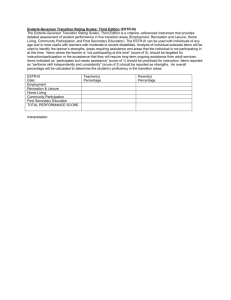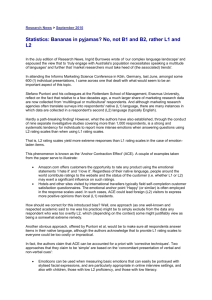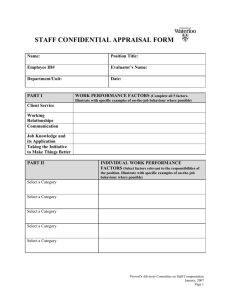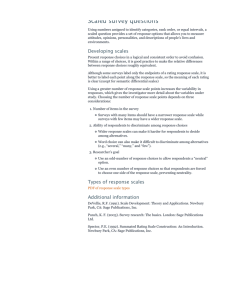Performance_Appraisal_Methods
advertisement
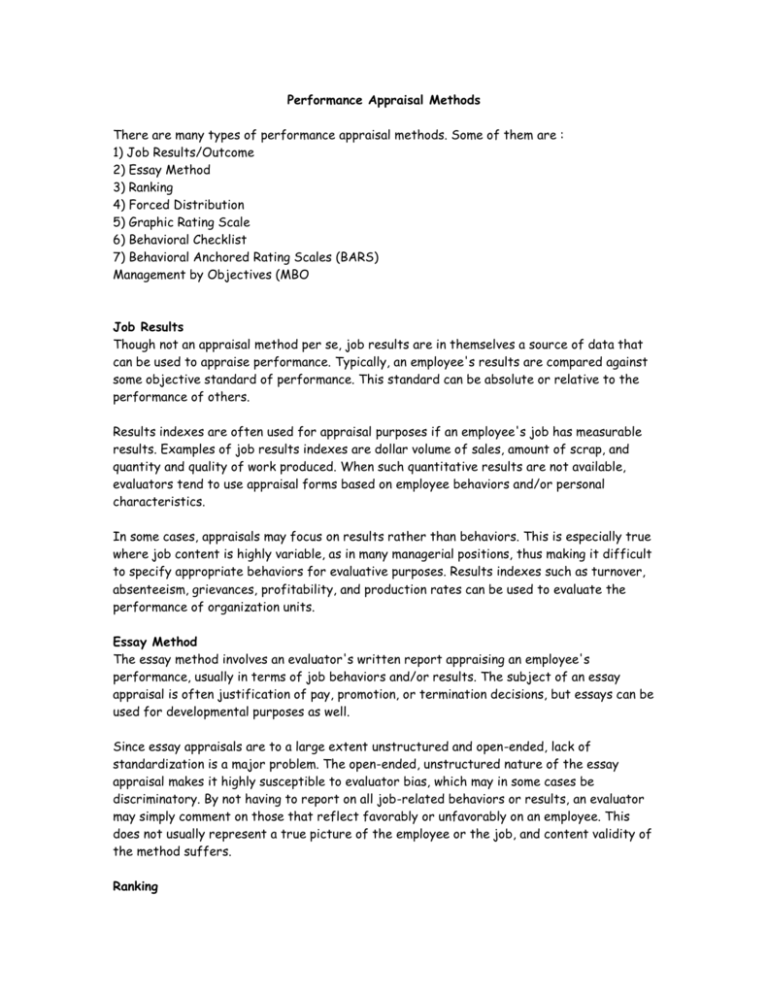
Performance Appraisal Methods There are many types of performance appraisal methods. Some of them are : 1) Job Results/Outcome 2) Essay Method 3) Ranking 4) Forced Distribution 5) Graphic Rating Scale 6) Behavioral Checklist 7) Behavioral Anchored Rating Scales (BARS) Management by Objectives (MBO Job Results Though not an appraisal method per se, job results are in themselves a source of data that can be used to appraise performance. Typically, an employee's results are compared against some objective standard of performance. This standard can be absolute or relative to the performance of others. Results indexes are often used for appraisal purposes if an employee's job has measurable results. Examples of job results indexes are dollar volume of sales, amount of scrap, and quantity and quality of work produced. When such quantitative results are not available, evaluators tend to use appraisal forms based on employee behaviors and/or personal characteristics. In some cases, appraisals may focus on results rather than behaviors. This is especially true where job content is highly variable, as in many managerial positions, thus making it difficult to specify appropriate behaviors for evaluative purposes. Results indexes such as turnover, absenteeism, grievances, profitability, and production rates can be used to evaluate the performance of organization units. Essay Method The essay method involves an evaluator's written report appraising an employee's performance, usually in terms of job behaviors and/or results. The subject of an essay appraisal is often justification of pay, promotion, or termination decisions, but essays can be used for developmental purposes as well. Since essay appraisals are to a large extent unstructured and open-ended, lack of standardization is a major problem. The open-ended, unstructured nature of the essay appraisal makes it highly susceptible to evaluator bias, which may in some cases be discriminatory. By not having to report on all job-related behaviors or results, an evaluator may simply comment on those that reflect favorably or unfavorably on an employee. This does not usually represent a true picture of the employee or the job, and content validity of the method suffers. Ranking Ranking methods compare one employee to another, resulting in an ordering of employees in relation to one another. Rankings often result in overall assessments of employees, rather than in specific judgments about a number of job components. Straight ranking requires an evaluator to order a group of employees from best to worst overall or from most effective to least effective in terms of a certain criterion. Alternative ranking makes the same demand, but the ranking process must be done in a specified manner (for example, by first selecting the best employee in a group, then the worst, then the second-best, then the second-worst, etc.). Comparative evaluation systems such as ranking are rarely popular. No matter how close a group of employees is in the level of their performance, and no matter how well they perform on the job, some will rank high and some will end up at the bottom. Evaluators are often reluctant to make such discriminations. Also, rankings are unable to compare employees across different groups. For example, it is difficult to say whether the secondranked employee in unit A is as good as or better than the second-ranked employee in unit B. Despite the problems of ranking methods, if an organization has a very limited number of promotions or dollars to allocate, rankings can be very useful in differentiating among employees. Forced Distribution Forced distribution is a form of comparative evaluation in which an evaluator rates subordinates according to a specified distribution. Unlike ranking methods, forced distribution is frequently applied to several rather than only one component of job performance. Use of the forced distribution method is demonstrated by a manager who is told that he or she must rate subordinates according to the following distribution: 10 percent low; 20 percent below average; 40 percent average; 20 percent above average; and 10 percent high. In a group of 20 employees, two would have to be placed in the low category, four in the below-average category, eight in the average, four above average, and two would be placed in the highest category. The proportions of forced distribution can vary. For example, a supervisor could be required to place employees into top, middle, and bottom thirds of a distribution. Forced distribution is primarily used to eliminate rating errors such as leniency and central tendency, but the method itself can cause rating errors because it forces discriminations between employees even where job performance is quite similar. For example, even if all employees in a unit are doing a good job, the forced distribution approach dictates that a certain number be placed at the bottom of a graded continuum. For this reason, raters and ratees do not readily accept this method, especially in small groups or when group members are all of high ability. Graphic Rating Graphic rating scales are one of the most common methods of performance appraisal. Graphic rating scales require an evaluator to indicate on a scale the degree to which an employee demonstrates a particular trait, behavior, or performance result. Rating forms are composed of a number of scales, each relating to a certain job or performance-related dimension, such as job knowledge, responsibility, or quality of work. Each scale is a continuum of scale points, or anchors, which range from high to low, from good to poor, from most to least effective, and so forth. Scales typically have from five to seven points, though they can have more or less. Graphic rating scales may or may not define their scale points. Acceptable rating scales should have the following characteristics: 1. Performance dimensions should be clearly defined. 2. Scales should be behaviorally based so that a rater is able to support all ratings with objective, observable evidence. 3. Abstract trait names such as "loyalty," "honesty," and "integrity" should be avoided unless they can be defined in terms of observable behaviors. 4. Points, or anchors, on each scaled dimension should be brief, unambiguous, and relevant to the dimension being rated. For example, in rating a person's flow of words, it is preferable to use anchors such as "fluent," "easy," "unimpeded," "hesitant," and "labored," rather than "excellent," "very good," "average," "below average," and "poor." Carefully constructed graphic rating scales have a number of advantages: 1. Standardization of content permitting comparison of employees. 2. Ease of development use and relatively low development and usage cost. 3. Reasonably high rater and ratee acceptance. A disadvantage of such rating scales is that they are susceptible to rating errors which result in inaccurate appraisals. Possible rating errors include halo effect, central tendency, severity, and leniency. The halo effect occurs when a rating on one dimension of an appraisal instrument substantially influences the ratings on other dimensions for the same employee. As a result of the halo effect, an employee is rated about the same across all performance dimensions. Central tendency is a lack of variation or difference among ratings of different subordinates, wherein most employees tend to be rated as average. Leniency refers to an evaluator's tendency to rate most employees very highly across performance dimensions, whereas severity refers to the tendency to rate most employees quite harshly. Mixed Standard Scales Mixed standard scales are a relatively recent innovation in rating scales. They contain statements representing good, average, and poor performance based on behavioral examples obtained from knowledgeable persons, usually supervisors. An evaluator's task is to indicate whether an employee either fits the statement, is better than the statement, or worse than the statement. In a mixed standard scale, each performance dimension has three statements relating to it: one illustrating good performance, one average, and one poor. Thus, this mixed standard scale has nine statements, three for each of the three dimensions used. Statements in mixed standard scales are randomly mixed, tending to reduce rater errors by making it less obvious which statements reflect effective or ineffective performance. Example of a mixed standard scale Instructions: If the employee fits the statement, put a ?=? in the space opposite the statement. If the employee is better than the statement, put a ?v?. If the employee is worse than the statement, put ?x?. 1. Is on good terms with everyone. Can get along with people even in disagreement. 2. Employee's work is spotty, sometimes being all right and sometimes not. Could be more accurate and careful. 3. Has a tendency to get into unnecessary conflicts with people. 4. Is quick and efficient, able to keep work on schedule. Really gets going on a new task. 5. The accuracy of employee's work is satisfactory. It is not often that you find clear evidence of carelessness. 6. Gets along with most people. Only very occasionally has conflicts with others on the job, and these are likely to be minor. 7. Is efficient enough, usually getting through assignments and work in reasonable time. 8. Work is striking in its accuracy. Never any evidence of carelessness in it. 9. There is some lack of efficiency on employee's part. Employee may take too much time to complete assignments, and sometimes does not really finish them. Behavioral Checklist A behavioral checklist is a rating form containing statements describing both effective and ineffective job behaviors. These behaviors relate to a number of behavioral dimensions determined to be relevant to the job. Items from a behavioral checklist for a salesperson's job Instructions: Please check those statements descriptive of an employee's behavior. 1. Calls on customers immediately after hearing of any complaints 2. Discusses complaints with customer 3. Gathers facts relevant to customers' complaints 4. Transmits information about complaints back to customers and resolves problems to their satisfaction 5. Plans each day's activities ahead of time 6. Lays out broad sales plans for one month ahead 7. Gathers sales information from customers, other salesmen, trade journals, and other relevant sources Behavioral checklists are well suited to employee development because they focus on behaviors and results, and use absolute rather comparative standards. An advantage of behavioral checklists is that evaluators are asked to describe rather than evaluate a subordinate's behavior. For this reason, behavioral checklists may meet with less evaluator resistance than some other methods. An obvious disadvantage of behavioral checklists is that much time and money must be invested to construct the instrument. BARS - Behaviorally Anchored Rating Scales Behaviorally anchored rating scales (BARS) are rating scales whose scale points are defined by statements of effective and ineffective behaviors. They are said to be behaviorally anchored in that the scales represent a continuum of descriptive statements of behaviors ranging from least to most effective. An evaluator must indicate which behavior on each scale best describes an employee's performance. BARS differ from other rating scales in that scale points are specifically defined behaviors. Also, BARS are constructed by the evaluators who will use them. There are four steps in the BARS construction process: 1. Listing of all the important dimensions of performance for a job or jobs 2. Collection of critical incidents of effective and ineffective behavior 3. Classification of effective and ineffective behaviors to appropriate performance dimensions 4. Assignment of numerical values to each behavior within each dimension (i.e., scaling of behavioral anchors) Sample of BARS INTERPERSONAL SKILL DESCRIPTION: Develops and maintains a friendly rapport with others; demonstrates a sensitivity to their feelings; respects the dignity of others and responds with empathy to their own sense of self-worth. Ratings 1 and 2: Demonstrates the ability to get along well with subordinates, managers, and peers; strives to achieve work group objectives. Can express own ideas, thoughts, and feelings and considers the needs, ideas, and feelings of others. Ratings 3 and 4: Demonstrates the ability to apply factors of effective listening, on a oneto-one basis, such as displaying interest, not interrupting when another is speaking, and withholding judgments. Consistently provides honest (both positive and negative) feedback and provides constructive criticism when appropriate. Ratings 5 and 6: Demonstrates the ability to consistently consider and respond to the needs and ideas of others which encourages and stimulates further communication. Effectively listens in group or one-to-one situations involving distractions, stress, complex information, or when the person speaking is emotional/distraught. Creates/maintains a positive working environment that encourages expression of thoughts, ideas, and feelings. Management by Objectives Management by objectives (MBO) involves setting specific measurable goals with each employee and then periodically discussing his/her progress toward these goals. The term MBO almost always refers to a comprehensive organization-wide goal setting and appraisal program that consist of six main steps: 1. Set the organization?s goals. Establish organization-wide plan for next year and set goals. 2. Set departmental goals. Here department heads and their superiors jointly set goals for their departments 3. Discuss and allocate department goals. Department heads discuss the department's goals with all subordinates in the department (often at a department-wide meeting) and ask them to develop their own individual goals; in other words, how can each employee contribute to the department's attaining its goals? 4. Define expected results (set individual goals). Here, department heads and their subordinates set short-term performance targets. 5. Performance review and measure the results. Department heads compare actual performance for each employee with expected results. 6. Provide feedback. Department heads hold periodic performance review meetings with subordinates to discuss and evaluate progress in achieving expected results.

